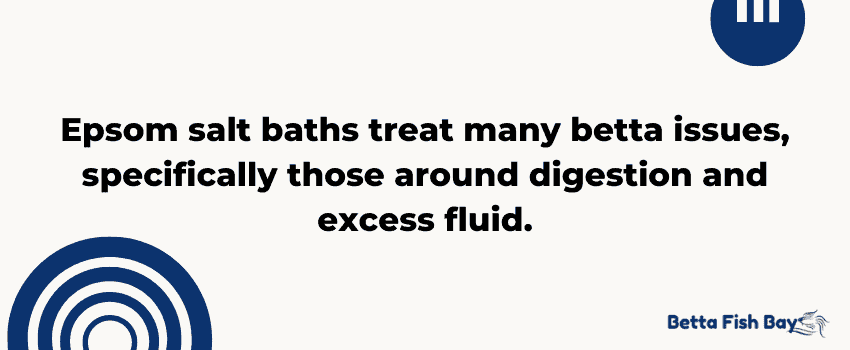Bettas are hardy fish, but they still get sick from time to time.
There are several over-the-counter medications for treating common diseases in betta fish.
One of the most popular treatments for bettas is an Epsom salt bath.
Epsom salt is not the same as aquarium salt. Aquarium salt contains sodium, and Epsom salt is magnesium sulfate.
But how does an Epsom salt bath help a betta fish?
Epsom salt acts as a muscle relaxant in betta fish, making it an effective laxative. It also helps relieve water retention as it gets absorbed in a betta’s body. An Epsom salt bath is a common remedy for bettas suffering from constipation, bloating, and swim bladder disease.

Table of Contents
Is Epsom Salt Safe for Betta Fish?
Epsom salt is completely safe for betta fish when used in the correct dosage.
The Epsom salt you use with your betta should not contain any dyes or scents. A lavender-scented Epsom salt can make a relaxing bath for you, but it is toxic to your betta.
You must also give your betta Epsom salt baths in moderation. Overexposure to Epsom salt may be harmful to your betta.
An Epsom salt bath treatment usually lasts no more than 15 minutes per session. You may repeat the treatment for up to 10 days.
If your betta shows no improvement after a few Epsom salt baths, consult your veterinarian.
Epsom salt baths are not a cure for all betta diseases. Your betta needs stronger prescription medication for severe illness.
While Epsom salt is safe for betta fish, it is unsafe for snails or scaleless fish in your tank. This is due to the high magnesium concentration.
Adding a high dosage of Epsom salt also affects your water chemistry. It can increase water hardness and affect pH levels.
Avoid upsetting your water parameters by giving your betta an Epsom salt bath in a separate container.
How Do You Use Epsom Salt for a Betta Bath?
Making an Epsom salt bath for your betta is a simple process.
First, you must gather your supplies. For an Epsom salt bath, you need:
- Two small containers
- Measuring spoon
- Thermometer
- Small net or cup for transferring your betta
- Timer or stopwatch
- Water conditioner/dechlorinator
Having everything you need ahead of time makes the Epsom salt bath process easier.
For a visual Epsom salt bath guide, check out the video here:

Epsom Salt Dosage Recommendations
- Constipation: 1 tablespoon of Epsom salt per gallon of water
- Swim Bladder Disease: 1 teaspoon of Epsom salt per gallon of water
- Dropsy: 1 teaspoon of Epsom salt per gallon of water
Prepare the Epsom Salt Bath
Prepare a mixture of Epsom salt and treated water in the first container. Use the recommended dosage for your betta’s ailment.
Ensure the water is at the same temperature as the water in the main tank. This prevents temperature shock in your betta.
You may boil the water before adding the salt to warm it. Use a thermometer to check the temperature before adding your betta.
Stir the water so the Epsom salt dissolves completely.
Prepare the Revival Bath
A revival bath acclimates your betta before placing it back in the main tank. This reduces the risk of potential shock and stress to your betta.
Prepare a revival bath with 1/4 of the Epsom salt bath and 3/4 dechlorinated water.
Once again, ensure the water is at the same temperature as the water in the main tank.
Place Your Betta in the Epsom Salt Bath
Place your betta in the Epsom salt bath using the net or a small cup of tank water.
Let your betta swim in the Epsom salt bath for 5-15 minutes. The length of the bath depends on the severity of your betta’s illness.
Watch your betta for any signs of distress. If your betta seems distressed or passes out, immediately move it to the revival bath.
When your betta’s gills stop moving, or it has difficulty staying upright, it is about to pass out.
If your betta remains unconscious in the revival bath, immediately move it to the home tank.
Place Your Betta in the Revival Bath

After the Epsom salt bath, move your betta into the revival bath.
Since the revival bath has less Epsom salt, it acclimates your fish before putting it back into the tank.
The revival bath helps if your betta passes out in the Epsom salt bath.
Leave your betta in the revival bath for about 5-8 minutes.
Place Your Betta Back in the Main Tank
Once your betta has acclimated to the revival bath, move your fish back to its main tank.
Keep an eye on your betta and watch for any signs of complications from the Epsom salt bath.
If your betta shows adverse effects, do not treat it with Epsom salt again.
6 Helpful Tips for Safe Epsom Salt Treatment
- Set a timer so you do not leave your betta in the Epsom salt bath for too long.
- Have everything set up before you begin so you do not stress your betta too much.
- If your betta has constipation, stop feeding your fish 24-48 hours before the Epsom salt bath.
- Be gentle when moving your betta to and from the salt bath to reduce the risk of shock.
- Use the shortest amount of time necessary for the Epsom salt bath.
- You may add a heater for a dedicated quarantine tank for more stable water temperatures.
How Often Should You Give Your Betta an Epsom Salt Bath?

You may repeat the Epsom salt bath once daily if your betta’s disease symptoms improve.
Treatment may last for 7-10 days. If your betta is not better after this time, consult a veterinarian.
The inflammation and bloating in your betta could be a sign of a bacterial disease or infection. If this is the diagnosis, your betta needs stronger medication.
Long-term use of Epsom salt is also associated with anemia and dehydration in betta fish.
Using any type of medication for a long period of time may cause internal organ failure in bettas.
Can You Mix Epsom Salt With Other Treatments?
It is unclear whether mixing Epsom salt with other medications is helpful for sick bettas.
Some fish owners have successfully mixed Epsom salt with aquarium salt or methylene blue.
But mixing treatments of any kind can lead to dangerous health consequences for your betta.
Some fish medications may have negative interactions with magnesium.
Medication treatments are stressful for bettas. Stress lowers a betta’s immune system, which does not help fight off diseases.
If you use more than one treatment at a time, you may not know which medication is helping your betta get well.
In some cases, mixing chemical compounds could make the illness worse.
I recommend using only one treatment at a time for a sick betta.
It is also best to wait a few days between different treatments. This lets you gauge how effective a single treatment is for your betta.
What Are the Benefits of Giving a Betta an Epsom Salt Bath?
There are currently no case studies on the benefits of Epsom salt baths for betta fish.
But anecdotal evidence suggests Epsom salt baths are effective for constipation and bloating.
When used in the correct dosage levels, Epsom salt does not harm betta fish.
The relief from bloating can keep your fish comfortable while it recovers.
Epsom salt also makes betta fish with tumors more comfortable by reducing excess fluids.
For minor illnesses caused by bloating, Epsom salt relieves your betta’s symptoms fast.
Epsom salt is also an inexpensive treatment option when other medications are unavailable.
Can I Use Epsom Salt for All Types of Betta Health Issues?

Epsom salt acts as a muscle relaxant and diuretic. It helps treat health conditions associated with bloating, such as:
- Constipation
- Swim bladder disease
- Dropsy
These common diseases usually have overlapping symptoms, including:
- Loss of appetite
- Bloating
- Lethargy
- Difficulty swimming
An Epsom salt bath relieves constipation in bettas by acting as a laxative.
Epsom salt helps with fluid retention and internal inflammation for swim bladder disease. This relieves the pressure on the swim bladder.
Swim bladder issues can result from constipation, high nitrate levels, or intestinal parasites. See veterinary care if Epsom salt does not cure your betta’s swim bladder disease.
There is no cure for dropsy in betta fish, but Epsom salt relieves the symptoms caused by abnormal fluid build-up.
Epsom salt may curb the inflammation of popeye disease. In popeye caused by bacteria or parasites, your betta needs stronger medication.
Can I Use Epsom Salt in My Betta’s Main Tank?
Some fish keepers add a constant dosage of Epsom salt to their aquarium for plant growth. The salt amounts vary from 1/8 to 1/4 teaspoons per 5 gallons of water.
This small dose is not enough to treat illnesses in your betta.
Epsom salt does not affect plants because it acts as a natural fertilizer. But there is no evidence Epsom salt contains enough magnesium in such small doses for increased plant growth.
Epsom salt also increases water hardness, which affects pH levels.
Long-term usage of Epsom salt may cause anemia and dehydration in bettas. Dehydration may cause kidney failure and other severe health conditions in betta fish.
I recommend only using Epsom salt for salt baths rather than dosing the entire tank. This reduces the risk of negative effects on your betta and water parameters.
Alternative Treatments for Common Betta Illnesses

Some fish medications have harsh side effects for bettas.
But, there are a few natural ways of treating minor illnesses in bettas.
Epsom salt baths are not the only way to relieve bloating and constipation in betta fish.
Feeding daphnia to your betta helps with digestion and bowel movements.
Aquarium salt is a common treatment for mild cases of bacterial and fungal infections. It works by increasing a betta’s production of its slime coat.
Indian almond leaves contain antifungal properties and promote healing. Placing Indian almond leaves in your betta tanks helps heal minor injuries and fin rot.
The tannins from Indian almond leaves may also improve water conditions and lower stress levels in your betta.
Avoid using medications containing tea tree oil with bettas.
Tea tree oil is a natural product, but it causes suffocation in bettas. This is because it coats the labyrinth organ.
Always follow dosage instructions when treating your betta for an illness. Even if a treatment is natural, it can still be fatal in high doses.
See veterinary care if alternative remedies do not improve your betta’s health condition.
Frequently Asked Questions About Epsom Salt Baths for Bettas
What’s the difference between aquarium salt, marine salt, and Epsom salt?
All salts are not created equal.
Aquarium salt contains sodium chloride. It treats minor injuries, bacterial infections, and some fungal infections. Use a quarantine treatment tank for aquarium salt treatments.
Aquarium salt accumulates in the water and is not removed by filters. Only water changes can decrease aquarium salt levels in the water. High salinity levels are deadly for freshwater fish, shrimp, and snails. Your live plants also will not survive aquarium salt treatments.
Marine salt also contains sodium chloride. But it has trace elements and other buffers meant for saltwater tanks. These buffers are harmful to bettas and other freshwater fish.
Epsom salt is a chemical compound of sulfur, magnesium, and oxygen. It is safe for short-term treatment of common diseases in betta fish.
Never put table salt in your betta tank! Table salt contains chemical compounds like iodine and anti-caking buffers. These chemicals are deadly to aquatic wildlife.
Will Epsom salt harm the beneficial bacteria in my betta fish’s aquarium?

Epsom salt absorbs excess fluid and dehydrates bacterial organisms.
Long-term usage of Epsom salt could dehydrate the beneficial bacteria in your tank. Without beneficial bacteria, your nitrogen cycle cannot support itself.
There is no clear evidence of Epsom salt harming beneficial bacteria. But it is not impossible.
Can I use Epsom salt as a replacement for regular aquarium water changes?
Do not use Epsom salt to replace regular water changes in your betta tank. Epsom salt can remove harmful toxins and heavy metals. But it will not lower ammonia or nitrite levels in your aquarium.
Treat Your Betta to a Spa Day With an Epsom Salt Bath
Epsom salt baths can treat various minor betta diseases caused by bloating.
Following the recommended dosages of Epsom salt is not harmful to your betta.
In most cases, your betta can quickly relieve uncomfortable symptoms caused by constipation or swim bladder disease.
If you have concerns or have never given your betta an Epsom salt bath, discuss it with your veterinarian first.
For more on betta constipation and treatment, check out our detailed guide at the link.


